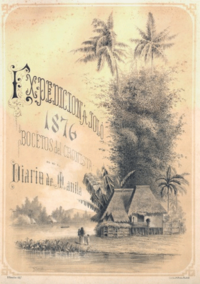- Diario de Manila
-
Diario de Manila 
Diario de Manila's special supplement covering the expedition to Jolo in 1876. Drawing by Baltasar GiraudierType Daily newspaper Format Broadsheet Publisher Ramirez y Compañia Editor Felipe del Pan Founded 1848 Political alignment Independent Language Spanish Ceased publication 1898 Headquarters Manila, Philippines Diario de Manila was a Spanish language newspaper published in the Philippines, founded on October 11, 1848, and closed down by official decree on February 19, 1898, after the colonial authorities discovered that its installations were being used to print revolutionary material.
The Diario was edited by Felipe del Pan and published by the Ramirez y Compañia, whose headquarters were based in Intramuros, Manila, and its business and editorial offices in Binondo.
Contents
History
The first daily of Manila, La Esperanza had been founded on December 1, 1846. Diario de Manila raised as a competitor just a couple of years later, during a time when a great number of native newspapers written in Spanish came into existence in the Philippines,
Notable contributors
Isabelo de los Reyes, a prominent Filipino politician, writer and labor activist in the 19th and 20th centuries, who was the founder of the Aglipayan Church, worked as a journalist and wrote several articles for the newspaper, such as the “Invasion of Limahong”, which appeared in the Diario de Manila in November 1882. He eventually became the associate editor of the Diario.
Enrique Gaspar y Rimbau, a Spanish diplomat and writer, author of plays,operas and novels, wrote for the Diario de Manila while serving as consul in Hong Kong.
Baltasar Giraudier, a famous Filipino artist and writer who published his work in both the Diario de Manila and in the Ilustración Filipina, accompanied Governor General Malcampo to Jolo during a organized military expedition that took place in February 1876 against the Muslim pirates who had been receiving a substantial amount of arms and ammunition during the previous years. Governor Malcampo commissioned Giraudier to illustrate the landscape of the island together with its people, customs and architecture. The resulting drawings are considered to be among the best lithographic illustrations of the Islands.
An article published in Diario de Manila by the Jesuit Father Jaime Nonell, which described observations of the typhoon of September 1865 done by Father Francisco Colina, prompted the establishment of the Observatorio Meteorológico del Ateneo Municipal de Manila.
Camilo Millan y Villanueva, former governor of several provinces in the Archipelago and government adviser, raised the issue of the reforms for the Philippines in an article published in 1897 titled "El gran problema de las reformas en Filipinas".[1]
Katipunan connection
In 1894 Emilio Jacinto started editing Kalayaan (Freedom), the Katipunan's official publication, thanks to the printing press of the Diario de Manila, and using typefaces stolen from the printing room by Filipino employees who were also members of the Katipunan.[2] They conducted their activities under the unsuspecting eyes of the management, who were mostly active members of the Spanish colonial reserve forces. Most of their secret activities took place during the two-and-a-half lunch breaks when the Spanish personnel took their meals and their siesta.
On August 19, 1896, one of those Katipunan members, Teodoro Patiño, who was on strong disagreement with press foreman de la Cruz over a salary increase and claimed he was also being made responsible for the loss of the printing supplies that were used for the Kalayaan, told all the story to his sister Honoria, who was then living with nuns in a Mandaluyong orphanage.[3]
Honoria was deeply disturbed by his brother's revelation and decided to inform the orphanage’s Mother Superior, Sor Teresa de Jesus, about the existence of the secret society. Sor Teresa in turn sought the advice of Father Mariano Gil, the parish priest of Tondo, who accompanied by several Guardias Civiles immediately searched the premises of Diario de Manila and found evidence of the Katipunan’s existence. They quickly informed the governor general who padlocked the printing press and arrested de la Cruz, who was found in possession of a dagger used in Katipunan initiation rites, and dozens of other suspected Katipunan members.
See also
References
- ^ Retana, W.E. (1895). El Periodismo Filipino. Madrid: Viuda de M. Minuesa de los Rios.
- ^ Zaide 1957, p. 158
- ^ "Katipunan". http://images.anipint87.multiply.com/attachment/0/R4mtyQoKCEIAAEC0CpY1/Chapter%208.doc?nmid=77355719. Retrieved 2010-08-22.
External links
Newspapers/Magazines in the Metro Manila market BroadsheetsBusiness Mirror • BusinessWorld • The Daily Tribune • Malaya • Manila Bulletin • Manila Standard Today • The Manila Times • The Philippine Chronicle • Philippine Daily Inquirer • The Philippine Star • Sino-Fil DailyTabloidsAbante • Abante Tonite • Bagong Tiktik • Balita • Bandera • Bomba Balita • Bulgar • Inquirer Libre • Pang-Masa • People's Journal • People's Monitor • People's Tonight • Pilipino Star Ngayon • Pinas • Pinoy Parazzi • Pinoy Weekly • Remate • Saksi sa Balita • Sikat • Taliba • Tanod • Tempo • TumbokMagazinesOnline-only Newspapers in the Metro Manila market BroadsheetsDefunct Newspapers/Magazines in the Metro Manila market BroadsheetsAng Kaibigan ng Bayan • Daily Globe • Diario de Manila • El Debate • La Ilustración Filipina • La Vanguardia • Mabuhay • Manila Chronicle • Philippines Daily Express • Philippine Herald • Today • Times Journal •TabloidsBanat • Bosero • Remate Tonight • RP Daily Exposé • ToroCategories:- Spanish-language newspapers
- Publications established in 1848
- National newspapers published in the Philippines
- Newspapers published in Metro Manila
- Defunct newspapers
- Newspapers published in the Philippines
- Defunct daily newspapers
Wikimedia Foundation. 2010.

